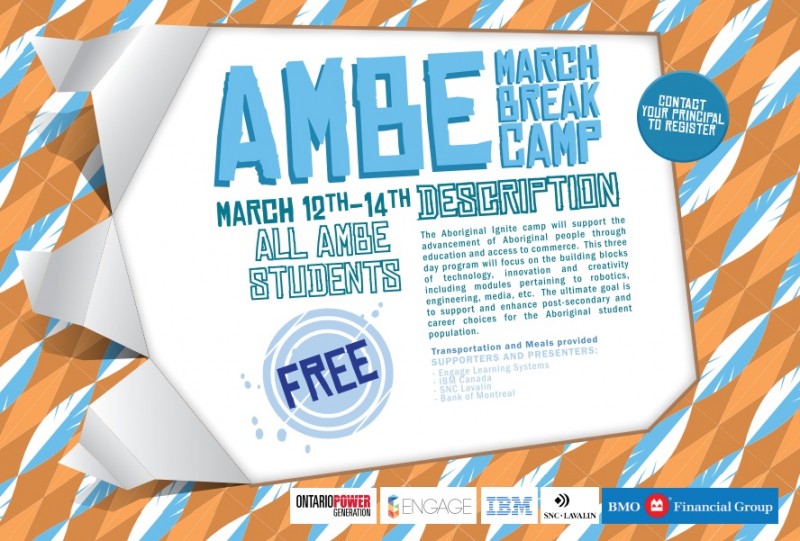
AMBE March Break Camp Activities
BMO Module Summary: (Bank of Montreal Financial Group)
Grades KG-3 and 4- 8, Days 1 and 3
Today’s kids are exposed to more gear, more gadgets, and more high-pressure advertising than ever before. How can today?s parents best prepare their kids to be prudent consumers and to manage money responsibly?
BMO SmartSteps® for Parents can help.
This is your user-friendly gateway to a wealth of expert advice, helpful articles, informative webisodes, expert blogs, and fun games and activities to help give you and your kids a head start on the road toward making money make sense for the entire family.
Pow-Wow-Opoly
Board Game is a native game. Learn and have fun playing the game, know what a “Indian Taco” is or that we always carry a little duct tape in our “Indian Car” for a quick repair jobs on our travels. Native Arts and Crafts. .Pow-Wow-Opoly Board Game, Indian Time Cards, Blanket Dance Cards, 6 Color Game piece, 2 Dice, and Native Money.
Engage Learning Module Summary:
Grades KG-3 and 4 – 8 Day 2, Develop, Shoot and Edit the Movie, Day 3 Air
the Movie
http://www.youtube.com/user/
This is our 3rd year in a row participating in educational technology camps with IBM. While working with us, students will be shown the different technologies that are used in modern video production and the new media as well as basics in composition, lighting, sound, and form.
.
The students will then assign themselves crew roles and spend the afternoon “on-set” writing, producing, directing, lighting, and sound designing their own video under our guidance. At the end of the camp the students will have a special screening of the video they produced and will leave the camp with a copy to show to their friends and family.
IBM Module Summary:
Grades KG-3 and 4 – 8, Day 1 Snap Circuits, Spaghetti Bridge, Puff Mobile,
Day 3 Lego Robotics, Snap Circuits
https://www.ibm.com/ibm/
IBM will include a variety of activities events at the camp, including Robotics, Snap Circuits, Spaghetti Bridge Building, Puff Car Building, as well as many of the projects defined in the IBM IGNITE Camp program. These activities will be introduced to the students on day 1, with Day 3 used for Robotics and Snap Circuits
OPG, Ontario Power Generators Module Summary:
OPG will be introducing the students to the world of Power Generation through Generation U, and the various activities available to the schools and students on their OPG.Com Education Site
SNC Lavalin Module Summary:
Grades KG-3: Civil Engineering Workshop
Two activities have been planned for Grades 1-3 students. The Design-a-Bridge activity, which an older volunteer will walk them through, will introduce them to the fundamentals of structural integrity, including how to use different shapes like arches and triangles to strengthen their bridges. In the second activity, students will be given a set of materials with which to build the tallest free-standing tower they can in the most cost-effective manner.
Following these activities, students will discuss what they have learnt about bridges and towers, what they would change about their designs having gone through both activities, and will be asked to explain their favorite design features of each bridge and tower.
Grades 4-8: Water for the World Workshop
In the next 25 years a third of the population will face severe water scarcity. With 20 percent of the world’s total freshwater resources and the longest marine coastline of any country in the world, Canada plays a pivotal role in managing global water resources. The next generation of Canadians must be well-equipped to tackle the world’s water challenges.
This workshop, developed by Engineers Without Borders Canada, will enable youth to do just that.
The workshop is 60-90 minutes in length, and starts with an opening discussion and slide show about local and global water issues and related technology, as well as the role of youth in addressing these challenges.
Following the discussion, students participate in an interactive activity in which they are separated into groups representing various countries. Each group is provided with differing levels of information and amounts of play money depending on their country’s literacy rate and national wealth.
They use their knowledge and resources to build a water filter from recycled bottles and layers of sand and gravel. During the activity students are encouraged to think critically and creatively while collaborating with their peers.

